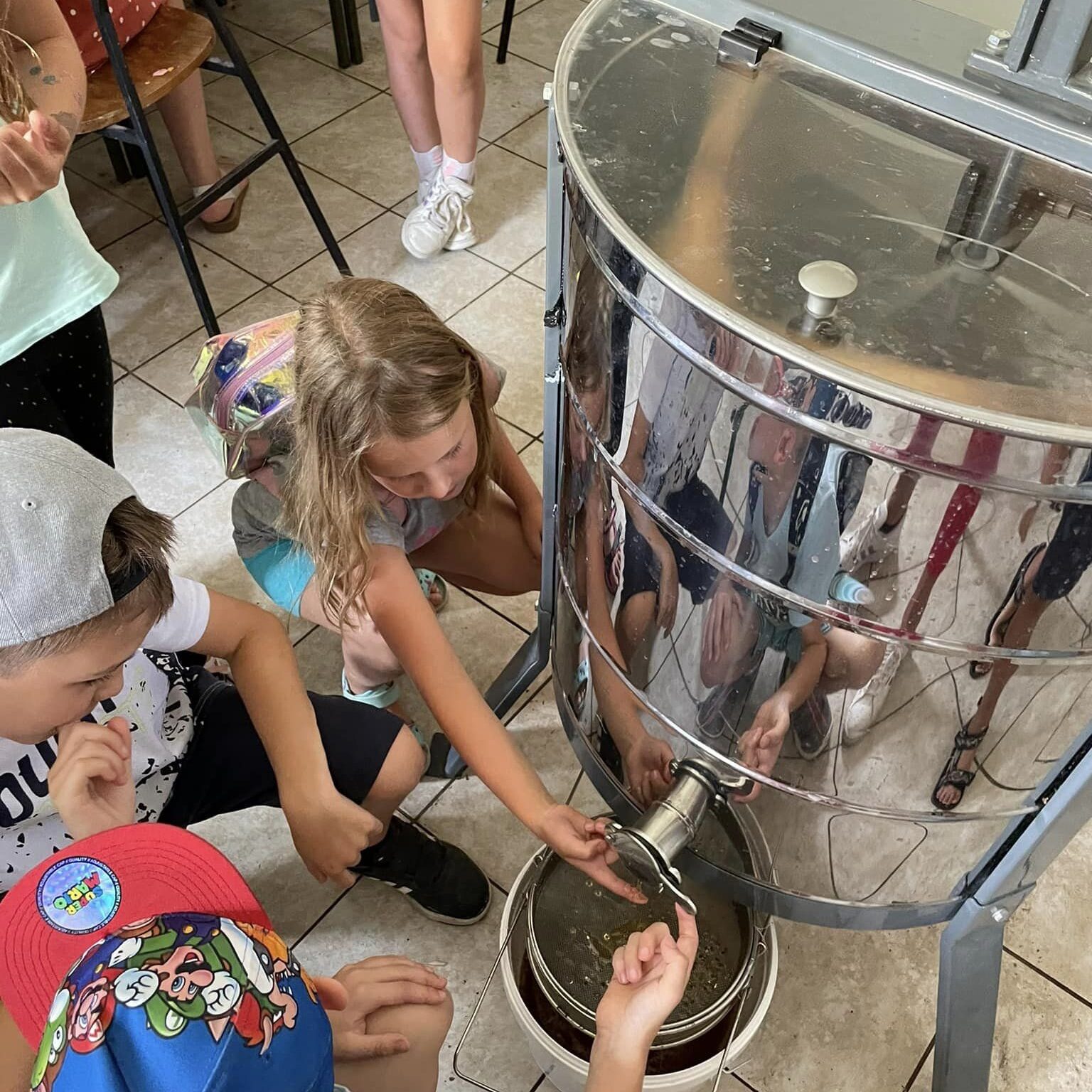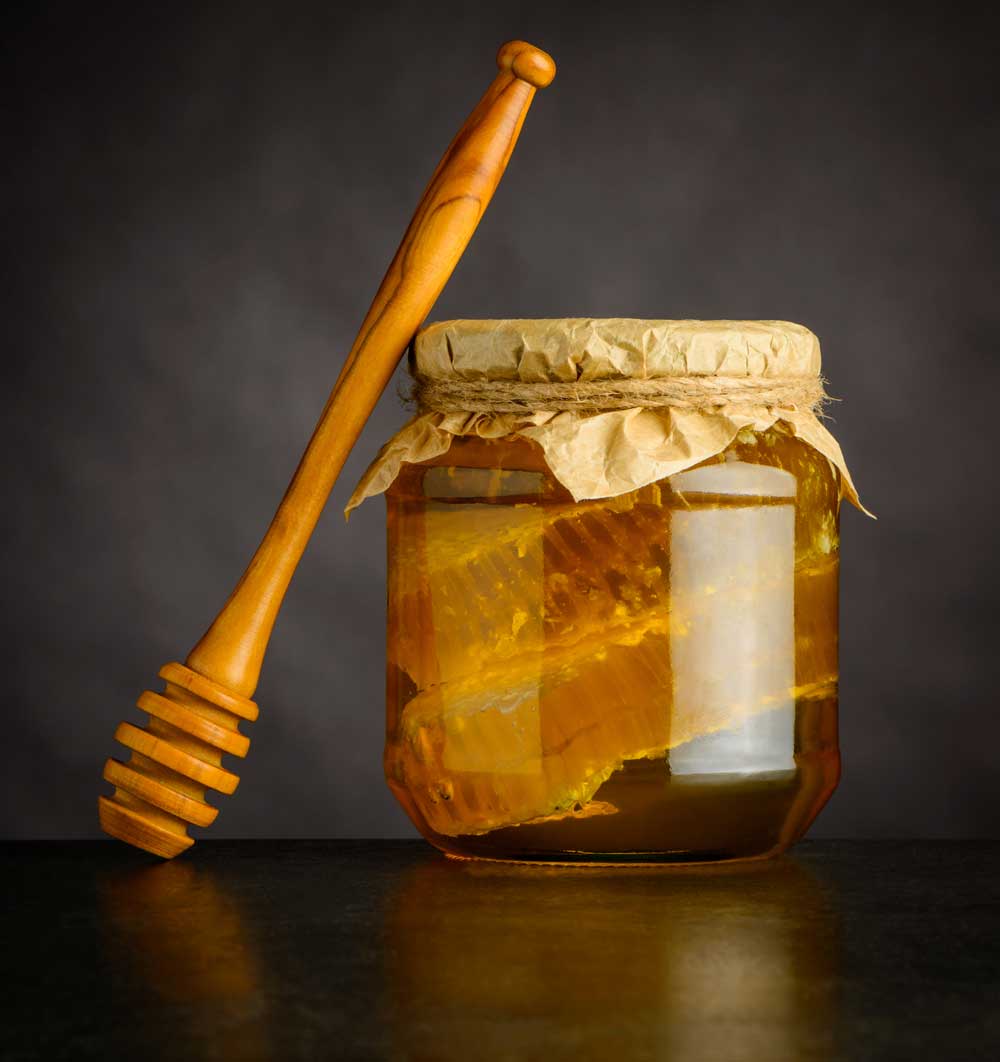
Honey
Honey is a natural food produced by honey bees (Apis mellifera) from nectar or plant sap.
How is honey made?
Nectar or honeydew is a sweet liquid, a secretion from the flowers of most flowering plants pollinated by insects. It mainly consists of water and sugars, with glucose, fructose, and sucrose being the predominant sugars. Honeydew is a natural, sweet, sticky sap produced by aphids and scale insects. Bees process and thicken honeydew or nectar in the hive, adding secretions from their glands, and store it in comb cells. Honey is obtained by centrifugation of the comb. It is then filled into suitable packaging, where it can be stored for several years under appropriate conditions. Honey intended for sale is not allowed to have any substances added, nor can any ingredients characteristic of honey be removed (Honey Regulation, 2011; 2015).
Honey from honeydew (forest honey)
Forest honey is light to dark brown, sometimes with a reddish hue. It is a mixture of different types of honeydew (secretions from insects that feed on phloem sap of trees). Therefore, forest honey can vary in color, smell, taste, and aroma. It’s characterized by the absence of any predominant type of honeydew. The smell of resin is quite intense and varies depending on the type of honeydew. Besides the resinous scent, notes of spruce bud syrup, smoke, gingerbread, and leaves may also be detected. The honey’s aroma is quite intense. Bees collect honeydew and nectar from various tree species and undergrowth plants during forest foraging. Hence, forest honey is diverse, depending on the prevalent species. Different forest honeys are classified based on the predominant type, such as spruce or fir honey, and mixed forest honey, a blend of honeydew or resin from conifers and deciduous trees, along with nectar from mountain flowers. Forest honey usually has a stronger aroma than floral honey, and it crystallizes fairly quickly. Electrical conductivity should be more than 0.8 mS/cm, averaging 1.3 mS/cm. Honey from honeydew is harmful to bees since it lacks as many nutrients as nectar honey, potentially causing the death of entire bee colonies if consumed excessively in winter. Therefore, it is crucial for beekeepers to remove this type of honey from hives before winter and provide bees with an additional protein source.
According to its proper composition, honey should be fifty percent denser than water. Being a sweetener, honey mainly consists of simple sugars that quickly enter the bloodstream and muscles, making it a rich source of energy with a rapid energy effect. It contains 77% sugars on average: approximately 34% glucose, 40% fructose, and 1 to 4% cane or beet sugar (sucrose). About 17.7% is water, and the remaining 5% consists of B-group vitamins and vitamin C (B1, B2, B6, C, …), minerals (Cu, Na, Ca, Si, Mg, Mn, Fe, K, …), amino acids, enzymes, hormones, acids, and mineral substances (potassium, calcium, sodium, magnesium, iron, chlorine, phosphorus, iodine, etc.). Dark honey varieties even contain up to 8 times more mineral substances than light ones.
Types of honey
Based on the geographical and botanical origin of honeydew, the method of production, and the season, different types of honey are known. Usually, honey is named after the plant from which bees collected nectar or honeydew. According to the Honey Regulation (2011; 2015), in line with the European directive (Directive 2001/110/EC of the Council of 20 December on honey and Directive 2014/63/EU of the European Parliament and of the Council of 15 May amending the honey directive), honey is classified according to the origin and method of acquisition. By origin, honey is divided into:
Floral honey, obtained mainly from the nectar of flowers. This category includes acacia, buckwheat, floral, dandelion, rapeseed, sunflower, and partly linden and chestnut honey.
Honey from honeydew, obtained mainly from secretions of insects on living plant parts or secretions from living plant parts. This category includes spruce, fir, forest, linden, and chestnut honey.
Floral Honey
Floral honey is a type of honey produced by bees from the nectar of various flowers. Bees collect nectar from flowers and bring it to the hive, where it is processed into honey. Each flower type imparts its distinctive taste and aroma to honey, making floral honey rich in diversity.
Floral honey is known for its variety of flavors. Bees collect nectar from numerous plants such as clover, sunflowers, linden, lavender, roses, and many others. This diversity is reflected in the taste of honey. Some types of floral honey have a mild taste with subtle sweetness, while others offer stronger and more spicy flavors. This allows you to choose your favorite flavor based on your preferences.
Floral honey also has an exceptional aroma. Each flower type contributes its unique scent, blending with the nectar in honey. Some floral honeys have sweet and flowery aromas, while others smell like fruit or herbs. Moreover, floral honey varies in color—from light yellow and golden to dark brown—depending on the flower type from which it was produced.
Floral honey is rich in natural nutrients. It contains essential vitamins, minerals, antioxidants, and enzymes. Honey is a natural sweetener providing carbohydrates that supply energy to the body. In addition, floral honey contains essential amino acids and vitamins such as vitamin C, vitamin B complex, and vitamin K.
Floral honey has long been recognized for its healing properties. It possesses antibacterial properties that aid in the healing of minor wounds and burns. Honey is also used to soothe coughs and sore throats. Some studies suggest that floral honey has anti-inflammatory and antioxidant effects, supporting heart health and the immune system.



HEALING EFFECTS
Honey has always been valued as a remedy for various ailments and wound healing. Honey is highly healing. Forest honey is most suitable for strengthening the immune system and the body’s resistance, helping with respiratory tract inflammation, easing expectoration, reducing cough, and facilitating breathing. Consuming honey also allows for better absorption of certain minerals and vitamins. Honey can act as an antibacterial and antifungal agent, alleviating inflammatory processes. It is used for coughs, hoarseness, throat inflammation, and provides relief for asthma. The use of honey yields positive results in minor wounds, throat or skin problems, digestive issues, and fungal diseases. It is frequently used for coughs resulting from a cold, with honey’s cough-relieving effect being known in many cultures for centuries. A teaspoon of honey taken just before bedtime or mixed in a glass of water or lukewarm tea significantly eases coughing. As a rich energy nutrient containing vitamins, minerals, and enzymes, honey is also suitable for use as a dietary supplement. It is beneficial for anemia, pregnancy, during periods of intense physical exertion, in cases of reduced immune system resistance, in old age, and during recovery from illness. Honey also has a calming effect, promoting relaxation and better sleep. Honey helps with muscle cramps, aids the digestive process, helps with heartburn, stomach or duodenal ulcers, and has a mild laxative effect (enhancing bowel movement). It also assists the liver in carbohydrate metabolism, toxin removal, and in cases of liver diseases. Honey soothes irritated and dry skin and is widely used in making soaps, shampoos, lotions, creams, and beauty masks.
Storing honey
Honey should be stored in a cool, dark place to preserve its color and aromas for an extended period. The most optimal temperature for use is between 18 and 24 °C. As storage time extends, honey may crystallize. At that point, we say the honey has crystallized. It is a natural occurrence that happens in almost all types of honey and depends on the ratio of glucose to fructose and the ratio of glucose to water. Honey with less glucose crystallizes later (quoted on March 5, 2023, at the link Crystallization occurs only in honey of natural origin. Crystallized honey is also edible, and with gentle heating (up to 40°C), it can be liquefied again. If honey is heated at too high a temperature, it loses its healing properties.
Spruce Honey
Recommended for coughs, bronchitis, and anemia.
Fir Honey
Used for anemia, respiratory diseases (bronchitis, tracheal inflammation), colds, flu, and bad breath. This type of honey triggers the mildest reaction in people allergic to honey.
Forest Honey
Used for respiratory tract inflammation, reduced immune system resistance, and nervous tension.
Sage Honey
Due to its small amount of essential oil, it acts as a mild disinfectant. It is also used for colds, coughs, facilitating expectoration, bronchitis, and better sleep.
Dandelion Honey
Used for colds.
Floral Honey
Acts as a natural remedy for allergies, especially hay fever. It helps with exhaustion and strengthens the heart and circulatory system.
Linden Honey
Used for colds, elevated body temperature, headaches, loss of appetite, and coughs. Since it promotes sweating, it is not recommended for heart patients.
Chestnut Honey
Contains more fructose than glucose, making it suitable for use under medical supervision by mild diabetic patients. It is also used for anemia, fatigue, and inadequate nutrition.
Connections
PROVIDERS

ŠEMEN ŠTEFAN S.P. PRODAJA MEDU
Lipa 145 A
9231 Beltinci

ČEBELARSKI CENTER MARIBOR
TRGOVINA JANA
Jana Pušnik Pokrivač s.p.
Tavčarjeva 11, 2000 Maribor
ČEBELARSKI CENTER MARIBOR
Streliška 150, 2000 Maribor

ČEBELARSTVO KOTNIK
Jože Kotnik, Prepuž 3, 2316 Zgornja Ložnica